Have you ever tried to assemble furniture without instructions? You can have all the components you need, but if you don’t know what the final result should look like, you may end up with extra screws and an upside-down bookcase. The same goes for developing software without a clear software requirements specification (SRS).
At Apriorit, we start any project by developing an SRS. Our business analysts gather stakeholder requirements, study relevant regulatory requirements, and research the market to gather all software requirements in one document. However, creating an SRS is a complex process. In this article, we examine the main challenges you might face, discuss how to overcome them, and share expert tips on effective SRS development from our business analysts (BAs).
This article will be useful for executives, product owners, and tech decision-makers who want to efficiently manage project expectations and outcomes with an efficient SRS.
What is an SRS and why is it important?
A software requirements specification describes a product to be developed. It commonly includes the purpose of the software, its use cases, functional and non-functional requirements, external and internal interfaces, and desired performance. A well-structured SRS is essential for a successful software project because it acts as a single source of truth for both the development team and stakeholders. It clearly defines project goals, requirements, and expectations, making sure that all team members are on the same page and avoiding miscommunication and scope creep.
Many specialists use the terms system requirements specification and software requirements specification interchangeably, but there’s a subtle difference. A system requirements specification focuses more on technical aspects such as hardware, network connections, and the technology stack. A software requirements specification covers these areas, but it also includes business logic, use cases, and many other project-specific details, making it more comprehensive.
Transform your vision into reality!
With Apriorit’s business analysis services, you can trust that your project will stay on track, meet deadlines, and align with your business goals.
An SRS is usually developed according to several guidelines, including ISO/IEC/IEEE 29148:2018, IEEE 830-1998, and CMMI for Development. These standards cover best practices for ensuring that requirements are complete, consistent, and testable. Each of them also plays a critical role in helping teams ensure that they can effectively capture, communicate, and manage software requirements depending on the needs of their specific project. However, a business analyst may deviate from these standards to adjust an SRS to a particular project’s needs.
Business analysts develop software requirements documentation after they elicit project requirements from stakeholders. A high-quality SRS:
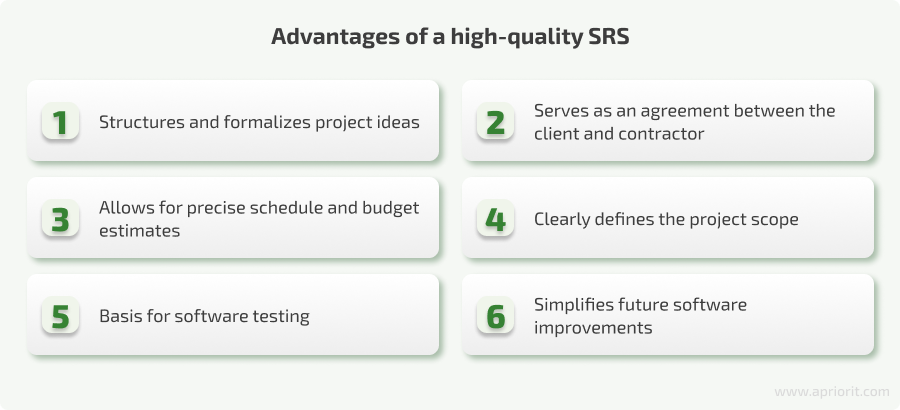
- Structures and formalizes the project’s views. Incoming requirements may be fragmented, inconsistent, or incomplete. When preparing an SRS, BAs structure requirements, identify gaps or unclear demands, and elicit requirements from stakeholders.
- Creates an agreement among all parties. An SRS acts as a communication tool, ensuring everyone is on the same page and resolving misunderstandings quickly by referring to the documentation. It contains all requirements that the client and the development company have discussed and agreed upon. If either party has doubts about the agreement, they can simply check the SRS.
- Clearly defines the project scope. An SRS outlines the priority of the requirements, which helps the development team plan project iterations, releases, and the scope of work.
- Allows for precise schedule and budget estimates. The development team can analyze SRS contents to draw up the budget and accurately estimate the project.
- Provides the basis for software testing. Quality assurance (QA) engineers test software against the SRS to determine if the developed solution complies with the client’s requirements.
- Simplifies future software improvements. If the client needs to upgrade the developed software, it’s easier for a new contractor to study it by analyzing the SRS than by investigating or reverse engineering the software itself.
An SRS eliminates guesswork and improvisation. It guarantees that the development process follows a clear path, ensuring you get the product you envisioned. The SRS becomes the most reliable reference point for the entire team throughout the project.
When choosing a format for your SRS, it is important to consider the specific needs of your project and the preferences of the people who will be using the SRS.
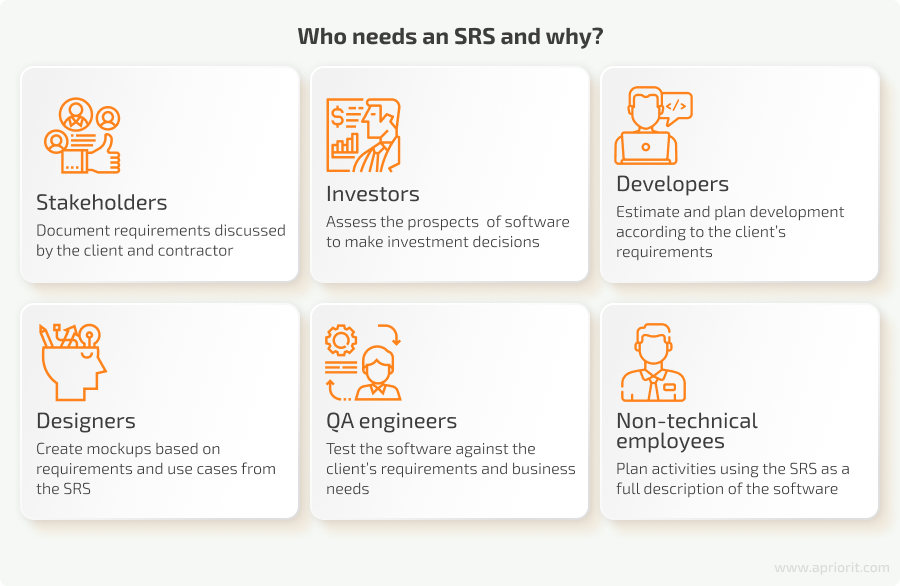
Here are the key risks of not paying enough attention to the SRS:
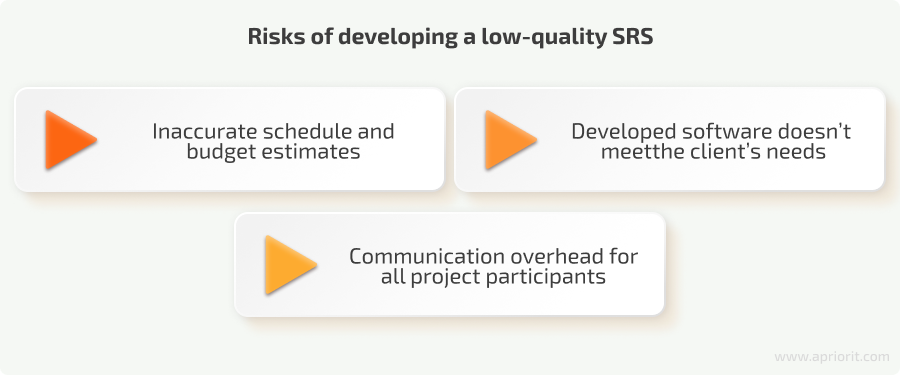
- Inaccurate schedule and budget estimates. Without a clear and complete software requirements specification, a development company can’t accurately estimate a project’s duration and budget, which might result in financial losses for the client.
- Developed software doesn’t meet all of the client’s needs. An overcomplicated or ambiguous SRS can confuse developers instead of guiding them. Developers may misunderstand a stakeholder’s requirements, and the client may end up with software that doesn’t meet their needs.
- Communication overhead for all project participants. A low-quality SRS doesn’t provide the project team with complete requirements. In this case, project BAs, developers, and stakeholders will have to hold many meetings to negotiate and clarify each next step.
The only way to mitigate all these risks is to establish a fine-grained SRS. However, this is not easy. First of all, your BAs need to establish a structure for your SRS that works for everybody involved in your project.
Read also
Business Analyst Roles & Responsibilities in Software Development
Looking to optimize team performance and guarantee project success? Learn how business analysts can help you bridge the gap between development teams and executives and make sure that your project stays on time, within budget, and aligned with your goals.
What is the structure of an SRS?
Depending on the project’s size, scope, and specific needs, the exact structure of the SRS may vary. However, there are core components that are typically included to ensure clarity and precision. So what does an SRS include? Below, you can see the general structure of an SRS that can be adjusted based on your project’s unique demands:
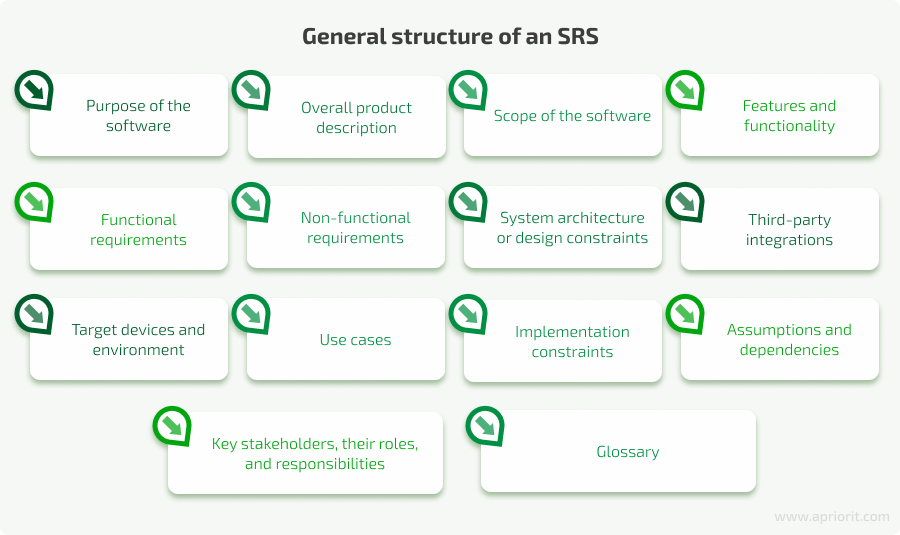
We usually adjust the custom structure of our SRS based on the project’s needs: for example, we can create a simplified version, which we will explore further in this article. In some projects, we also add a project roadmap to our SRS. This optional section provides a high-level timeline, milestones, or phases for development. Though a project roadmap is often part of other project documents, including it in the SRS helps us align the development team with the overall project plan.
Criteria checklist: How to write an SRS document
A well-crafted SRS prevents miscommunication, reduces the risk of project delays, and helps avoid costly rework because of unclear or incomplete requirements. By regularly reviewing and refining your SRS, you can make sure that it remains a clear, accurate, and flexible guide for both developers and stakeholders throughout the project. Here’s a list of criteria for evaluating the quality of your SRS:
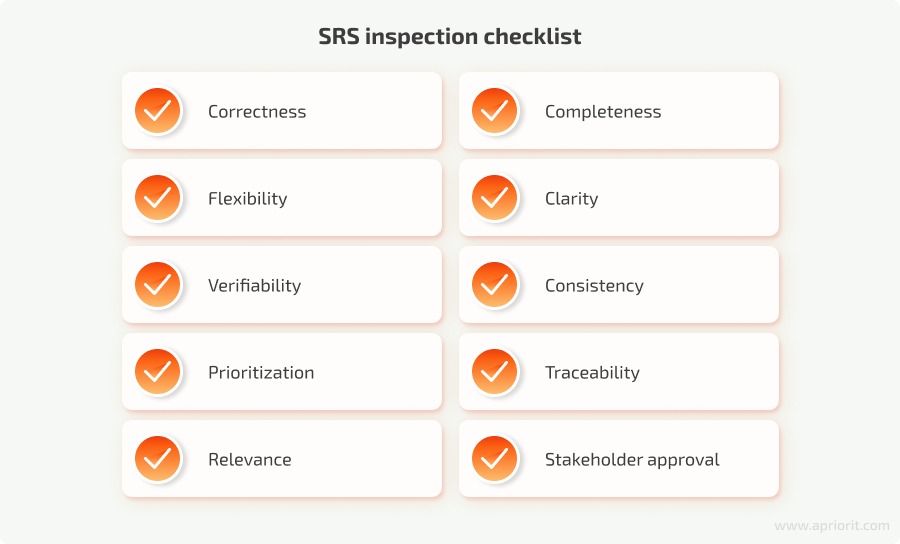
- Correctness. Verify that all requirements accurately reflect stakeholders’ needs and expectations.
- Completeness. Ensure the SRS covers all aspects of the project, leaving no crucial detail unaddressed.
- Flexibility. Make sure the document can accommodate future changes and updates without becoming overly complicated.
- Clarity. The SRS should be easy to understand, with clear, unambiguous language that avoids misinterpretation.
- Verifiability. Each requirement should be testable, meaning it can be measured against acceptance criteria.
- Consistency. Check that there are no conflicting requirements within the document.
- Prioritization. Ensure that the document highlights which features or requirements are critical.
- Traceability. Every requirement should be traceable back to its source, such as a stakeholder or business need.
- Relevance. Only include information that is pertinent to the project to avoid unnecessary complexity.
- Stakeholder approval. Finally, ensure that all stakeholders have reviewed and agreed on the SRS to prevent misalignment later in the project.
By checking these criteria, you can make sure that your SRS is robust, reliable, and aligned with your project’s objectives. You’ll likely find some areas that need improvement as you go through this checklist. Now that you know why an SRS is important and how to check for its effectiveness, we will look into common challenges faced when creating an SRS and how to overcome them.
Read also
Writing Clear Functional and Non-functional Requirements: Tips and Best Practices from Apriorit Experts
Our experts explain the differences between functional and non-functional requirements to help you better communicate project expectations, streamline your development process, and avoid costly misunderstandings.

Challenges of SRS development and how to overcome them
Creating a high-quality software requirements specification is challenging even for an experienced team of BAs. At Apriorit, we’ve worked out a set of best practices to overcome some of the biggest challenges of writing a software requirements specification:
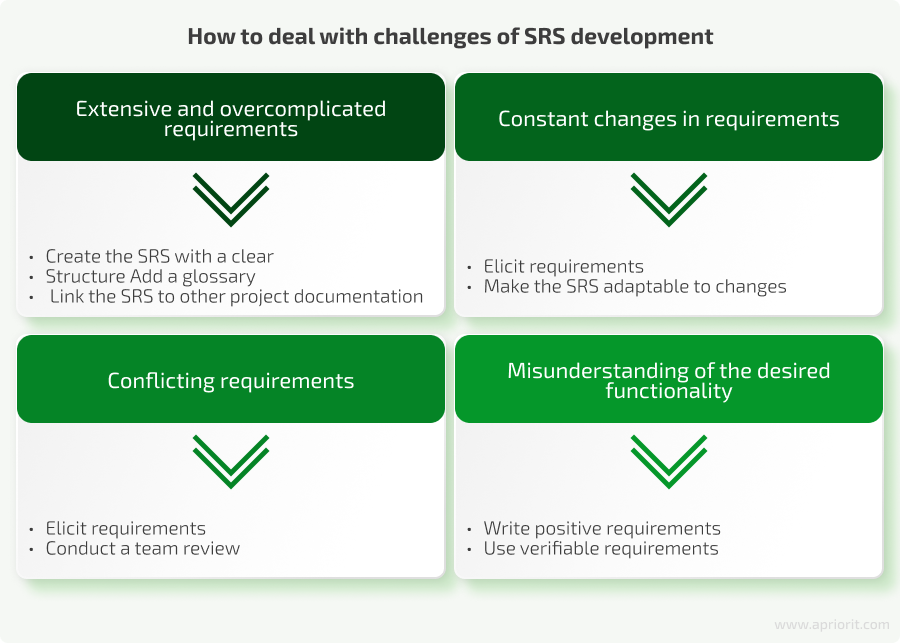
Extensive and overcomplicated requirements
This challenge is common for large projects with many stakeholders. When managing such projects, tech leaders must ensure that their BAs process requirements carefully before finalizing the SRS. To sort out complex requirements, your BAs can use the following best practices:
- Create the SRS with a clear structure. A well-structured SRS makes it easier for the project team to understand the requirements. Team leaders should ensure that the structure reflects both developers’ and stakeholders’ preferences, providing a format that works for both. For example, one of our clients doesn’t like user stories, so we prepare use cases and mockups instead. For another client, we combine user stories with mockups to make the user stories easier to visualize and understand.
- Add a glossary. A glossary is a source of terms used in the project and domain. In large development teams, unfamiliar terms can cause confusion, particularly across departments. In one of our projects, stakeholders used the words “payer,” “plan,” “health plan,” and “market” as synonyms for “insurance company.” That caused a lot of confusion until our BA added those definitions to the glossary.
- Link the SRS with other project documentation. An SRS isn’t the only source of project information in software engineering, and linking it with other documents allows your team to quickly find descriptions of necessary requirements. That’s why our BAs augment an SRS with references to analysis models, previous specifications, test cases, tasks in bug tracking systems, etc.
Constant changes to requirements
Changes to requirements are unavoidable in any project. Yet there are some projects where requirements keep coming in even after all project discussions are over. In this case, the development team can’t make progress, as they have to rework already developed functionality or add more features based on newly introduced requirements.
Here’s what your team can do to manage changes to the project scope and avoid delays:
- Elicit requirements. Elicitation is the process of researching, discussing, and augmenting stakeholders’ requirements. Encourage your BAs and development leads to focus on this phase to reduce the risk of surprise demands during development.
- Make the SRS adaptable to changes. Neverending changes to the SRS might make this document useless to the development team. We faced this issue in one of our company’s first projects. Our BA developed the SRS in full accordance with IEEE standards. However, because of many changes, the document became too long and too complex for the developers to follow. Based on our experience, we recommend developing a lightweight SRS that’s easy for developers to update and reference.
Conflicting requirements
This challenge is common for projects that have many stakeholders. Usually, these stakeholders belong to different departments and have diverging or even opposite opinions on the software. Simply writing all their requirements in an SRS will confuse the development team. Here is what you can do:
- Elicit requirements. The requirements elicitation discussed above is also useful for resolving requirement conflicts. Another practice that helps our BAs detect and work out such issues is conducting a team review of the SRS.
- Conduct a team review. Team reviews give developers, QAs, and designers the opportunity to ask questions about the SRS, gain a clear understanding of the functionality, and identify gaps in the requirements. After a review, you can be confident that everyone understands their responsibilities and shares the project vision.
Misunderstanding of the desired functionality
To ensure a correct understanding of the requirements, the wording of the SRS is as important as the logical structure of the document. A BA should constantly verify that the requirements are clear.
Besides eliciting and structuring the client’s requests, here are some strategies for achieving understanding:
- Write positive requirements. It’s often better to frame requirements in a positive light, avoiding negative phrases like “don’t.” This makes it easier for developers to implement them. For example, specifying that email notifications are sent when enabled in the user profile settings is clearer than saying they aren’t sent when disabled. However, negative constructions can be necessary for certain requirements, such as when prohibiting specific actions (for example, “the application must not require a system restart”).
- Use verifiable requirements. Statements like “the system must be stable” or “a large number of users must be able to access the system” might seem clear, but they lack specificity. Encourage your team to define requirements clearly, providing quantifiable parameters. This ensures that both developers and QAs can accurately assess whether the system meets the requirements.
By applying these best practices, you can guide your teams to develop SRS documents that are both useful and actionable for the entire project. Let’s see some of the practices that Apriorit experts use to create an efficient SRS.
Read also
Requirements Elicitation: Reasons, Stages, Techniques, and Challenges
Want to ensure your project runs smoothly from the start? Our experts share their actionable insights to enhance your project’s scope, budget, and timeline through the crucial process of requirements elicitation.

Apriorit’s approach to writing clear and effective SRS documentation
At Apriorit, we’ve developed a streamlined approach that focuses on clarity, efficiency, and adaptability. Our experts have worked out their own approach to creating this document to make sure that our SRSs not only help business analysts but also provide clarity and efficiency for developers, quality assurance teams, and stakeholders.
Here are the key practices for developing an SRS at Apriorit:
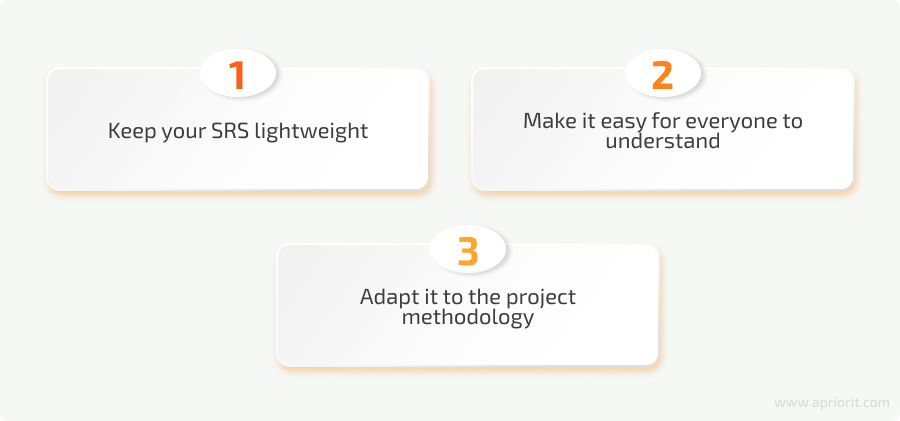
Keep the SRS lightweight. One key differentiator in our SRS approach is its lightweight structure, which we’ve refined based on years of experience. Traditional SRSs often become overly complex, forcing development teams to spend time deciphering documentation rather than building software. If you manage a large team, this inefficiency can significantly slow down project timelines. Apriorit addresses this by using a simplified structure with just five core components:
- Glossary
- Introduction
- General requirements
- Use cases (including preconditions, normal flows, exceptions, and postconditions)
- Mockups and UI descriptions
- Glossary
This streamlined format allows our team to quickly grasp requirements and start development without delays. As a result, team members spend less time studying the SRS.
Make it easy for everyone to understand. We combine formal written descriptions with visual models to enhance the clarity of the software requirements. These models not only complement the text but also help explain complex features to our teams, making sure that everyone is on the same page. Here are the visual models we typically use:
- Use case diagrams to depict relationships between users and actions they can perform in the software
- State diagrams to show the lifecycle of entities in the system
- Entity relationship diagrams to map relationships between database entities
- Data flow diagrams to illustrate how data is processed
- Business process model and notation to represent business activities
This combination of text and visual aids ensures that your team members get exactly the level of detail they need. For example, developers may need a more in-depth view with alternative flows, while stakeholders often require high-level summaries. This flexibility helps you tailor the documentation process to suit different team roles and expectations.
Adapt it to the project methodology. Our SRS development approach is always closely aligned with the project’s development methodology. At Apriorit, we prefer Agile development because it’s flexible and emphasizes communication inside the team. Agile projects are developed in small iterations, so we have to make sure that the SRS is adaptable to the fast pace and constant iterations of Agile workflows.
At the beginning of a project, BAs collaborate with stakeholders to specify the general software requirements and demands, which are continually refined throughout the project lifecycle. After that, developers and QAs can begin working with a clear set of expectations, while analysts continue refining requirements for future iterations.
Changes in requirements are particularly common for Agile projects. To ensure adaptability, we also publish an SRS in the project’s Confluence space and regularly update it. Centralized documentation helps tech leaders and their teams stay informed. Frequent updates call for high-level user stories and acceptance criteria, which are faster to adapt and adjust compared to formal software engineering specifications. This way, our development team can move quickly with the most up-to-date information.
These three rules help our BAs in writing an SRS document that is useful and easy for project teams to understand. If you want your project to have a similarly effective SRS, our experts are ready to help!
Related project
Developing an Advanced AI Language Tutor for an Educational Service
Explore our success story of collaborating with an eLearning provider to develop an AI-powered language tutor that boosted user engagement. We managed to attract new users while enhancing the client’s competitive advantage and scalability.

Conclusion
Creating a clear and complete requirements specification is just as important as designing software and writing code. A well-thought-through SRS allows the project team to estimate the project, calculate the budget, plan development, test the solution, and avoid miscommunication in the process.
Business analysts at Apriorit pay a lot of attention to creating an SRS document that is clear, precise, and aligned with your business goals. This allows our clients to move forward with confidence, knowing that their project will be delivered on time, fully meeting their specific requirements and successfully realizing their vision.
Unlock the full potential of your project
Bring clarity and efficiency to your software development with Apriorit’s expert business analysts and project managers.




